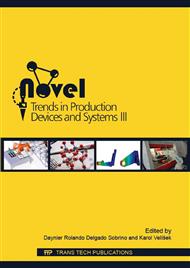[1]
P. Davim, J., Design of Experiments in Production Engineering. Cham: Springer International Publishing, (2016).
Google Scholar
[2]
M. Abouridouane, F. Klocke, and D. Lung, Microstructure-based 3D finite element model for micro drilling carbon steels, Procedia CIRP, vol. 8, p.94–99, (2013).
DOI: 10.1016/j.procir.2013.06.071
Google Scholar
[3]
A. G. Jaharah, Y. Hendri, C. H. E. H. C. H, R. Ramli, and Z. Yaakob, Simulation of Turning Process of AISI 1045 and Carbide Tool Using Finite Element Method, " Cybernetics, p.152–156.
Google Scholar
[4]
G. M. Pittalà and M. Monno, 3D finite element modeling of face milling of continuous chip material, " Int. J. Adv. Manuf. Technol., vol. 47, no. 5–8, p.543–555, (2010).
DOI: 10.1007/s00170-009-2235-0
Google Scholar
[5]
H. Zamani, J. -P. Hermani, B. Sonderegger, and C. Sommitsch, 3D Simulation and Process Optimization of Laser Assisted Milling of Ti6Al4V, Procedia CIRP, vol. 8, p.75–80, (2013).
DOI: 10.1016/j.procir.2013.06.068
Google Scholar
[6]
E. Babalová, Temperature Measurement and Finite Element Modeling Methodology for Laser Cutting of Stainless Steel Plate, Appl. Mech. Mater., vol. 474, p.321–326, (2014).
DOI: 10.4028/www.scientific.net/amm.474.321
Google Scholar
[7]
F. Ducobu, E. Rivière-Lorphèvre, and E. Filippi, On the introduction of adaptive mass scaling in a finite element model of Ti6Al4V orthogonal cutting, " Simul. Model. Pract. Theory, vol. 53, p.1–14, (2015).
DOI: 10.1016/j.simpat.2015.02.003
Google Scholar
[8]
R. Hill, A Theory of the Yielding and Plastic Flow of Anisotropic Metals, Proc. R. Soc. London A Math. Phys. Eng. Sci., vol. 193, no. 1033, p.281–297, May (1948).
DOI: 10.1098/rspa.1948.0045
Google Scholar
[9]
M. Calamaz, D. Coupard, and F. Girot, A new material model for 2D numerical simulation of serrated chip formation when machining titanium alloy Ti–6Al–4V, Int. J. Mach. Tools Manuf., vol. 48, no. 3–4, p.275–288, Mar. (2008).
DOI: 10.1016/j.ijmachtools.2007.10.014
Google Scholar
[10]
M. Martinkovič and P. Pokorný, Estimation of Local Plastic Deformation in Cutting Zone during Turning, Key Eng. Mater., vol. 662, p.173–176, (2015).
DOI: 10.4028/www.scientific.net/kem.662.173
Google Scholar
[11]
M. Kuzinovski, N. Trajcevski, and P. Cichosz, Investigation of cutting forces during machining process by high speed turning, " in 10-th International Scientific Conference MMA 2009, (2009).
Google Scholar


